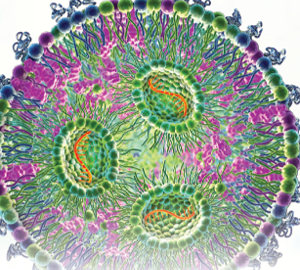
Unlocking the power of LNPs
For years, scientists have explored the potential of nucleic acid-based therapies in controlled laboratory settings. However, translating these promising experiments into real-world applications has been hindered by the complexities of delivering these therapies within living organisms. Standing at the forefront of a healthcare revolution, lipid nanoparticles (LNPs) have emerged as a solution, offering a means to shield therapeutic payloads from degradation while precisely targeting specific sites within the body.
These microscopic carriers, meticulously engineered at the intersection of nanotechnology and biomedicine, hold immense potential in overcoming longstanding challenges in drug delivery and therapeutic intervention, as well as addressing previously untreatable conditions, thus marking a paradigm shift in medical possibilities. LNPs have broadened the scope of druggable targets, enabling the transition from conventional small molecules to nucleic acid-based treatments.
Despite its burgeoning potential, the field of LNPs is still in its nascent stage, grappling with various hurdles on the path to unleashing its full capabilities. In this article, we shall assess these hurdles and explore the transformative power of lipid nanoparticles in an attempt to illuminate the path towards a future where targeted and efficient healthcare is a reality.
Navigating challenges in LNP implementation
The mRNA-based COVID-19 vaccines represented a simplified application of LNPs, administered infrequently with booster shots once the initial protection waned, delivered via easily administered intramuscular injection. While the transient nature of the payload contributed to the robust immune response elicited by mRNA-based COVID-19 vaccines, it poses a limitation in scenarios requiring sustained product persistence.
Efficient protein replacement requires alternative approaches however. Frequent dosing of LNPs may provoke immune responses and particle inactivation, but self-amplifying RNA (saRNA) holds promise in extending dosing intervals. SaRNA not only prolongs protein expression but also enables lower RNA doses, thereby minimising adverse effects. Although LNPs facilitate the delivery of gene editing tools like CRISPR/Cas9 and associated guide RNAs, ethical considerations accompany their potential for permanent therapeutic changes. Researchers are actively exploring modifications to LNP lipid composition and the incorporation of specific targeting ligands to address these challenges, yet substantial efforts are still required.
Pioneering advances in LNP technology
Similar to conventional medications, LNPs must be carefully formulated to ensure that their benefits outweigh the associated risks. It is imperative that LNPs maintain stability during storage and transit within the body, while evading detection by the immune system to effectively reach their intended target site of action. Ideally, LNPs should possess a sufficiently extended in vivo half-life while also being designed for swift and complete elimination, thus minimising the production of potentially harmful metabolites subsequent to the delivery of the nucleic acid payload.
Comprised of lipid mixtures including ionisable cationic lipids, helper lipids, sterol lipids, and PEGylated lipids, LNPs primarily rely on ionisable cationic lipids for encapsulating nucleic acid payloads and ensuring LNP efficacy. However, the properties of these ionisable cationic lipids also influence LNP tolerability, immunogenicity, and cellular toxicity.
Incorporating various environmentally responsive attributes into ionisable cationic lipids has significantly enhanced their biocompatibility and biodegradability. These lipids possess a transient positive charge under low pH conditions, which facilitates nucleic acid encapsulation, cellular delivery, and endosomal escape with minimal toxicity. Moreover, the inclusion of ester or amide linker groups enables enzymatic cleavage upon cellular uptake, promoting lipid degradation, while bioreducible disulfide bonds facilitate the release of nucleic acid cargo in the cytosol.
Target selectivity
While some target sites can be readily accessed through passive delivery mechanisms inherent in basic biology, others necessitate meticulously engineered active targeting strategies. Certain organ architectures naturally facilitate LNP accumulation; for instance, LNPs easily traverse organs with fenestrated epithelium or those receiving a significant portion of cardiac output, such as the liver, spleen, and lungs. Researchers have explored modifying LNP lipid compositions to enhance their affinity for these organs. Adjusting the net surface charge of LNPs allows for tissue tropism, where positively charged LNPs target the lungs, neutral LNPs target the liver, and negatively charged LNPs target the spleen. Additionally, employing a selective organ targeting (SORT) approach, involving the inclusion of a fifth lipid— a lipid SORT molecule— alongside the traditional four-component LNP mixture, may further refine LNP delivery. However, many diseases manifest in locations beyond the liver, spleen, and lungs, therefore expanding the clinical utility of LNPs necessitates devising strategies to achieve targeted delivery to diverse anatomical sites.
Charting the future of LNP innovation
The future of LNP technology lies in collaborative research efforts and the exploration of novel lipid formulations. By harnessing insights from diverse scientific disciplines and leveraging advanced research tools, the potential of LNPs to revolutionise healthcare can be fully realised.
Cayman Chemical stands as a stalwart partner in advancing LNP research, offering a comprehensive array of high-purity lipids and cutting-edge services. With over four decades of expertise in lipid chemistry, synthesis, and purification, Cayman Chemical is committed to fueling groundbreaking discoveries within LNP research, and therefore have an extensive portfolio of LNP research tools available to help facilitate this vision.
Inspired by original Cayman Chemical content. Read the original article in their Cayman Currents LNP edition.
